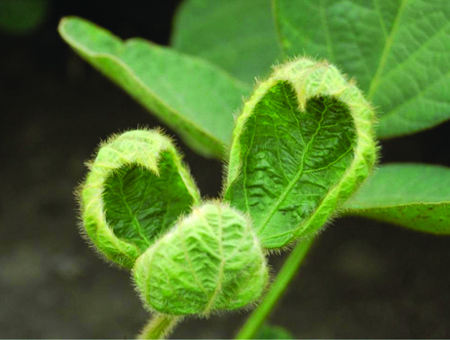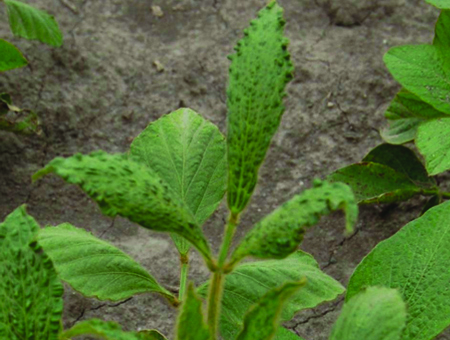Experts Cite Only One Certain Cause of Soybean Leaf Cupping: Dicamba

In the summer months, U.S. farmers often see herbicide damage in their soybean fields.
Soybeans that are not tolerant to dicamba are extremely sensitive to dicamba drift. Off-target movement of dicamba — even at very low levels — can result in leaf malformation known as “cupping,” which can affect plant growth and yield.
Cupping is distinguishable from other leaf symptoms due to its distinct appearance and effect on leaves. Multiple university weed scientists, after years of study, have found no culprit other than dicamba that causes potentially damaging leaf cupping in soybeans without the dicamba trait.
Speculations have arisen that other causes, such as Enlist® herbicides, AMS and glufosinate (Liberty® herbicide), also may cause cupping. Weed scientists reject this speculation.
“There is no scientific evidence that AMS can cause leaf cupping in soybeans,” says Prashant Jha, a professor and Extension weed specialist with the agronomy department at Iowa State University.
In a 2022 blog post, Jha says: “At higher rates or under stress conditions, it may cause leaf burns, but not a cupping response. Nor will [applications of Liberty herbicide] on glufosinate-tolerant or Enlist [E3] soybeans cause cupping. Moreover, we have been using AMS with glyphosate for past several years over millions of acres of glyphosate-tolerant soybeans, but no leaf cupping has been reported.”
Jha goes on to address rumors of Enlist herbicides causing cupping.
“This is also not a valid speculation based on multiple studies conducted by university researchers,” Jha says. “The 2,4-D symptomology on soybean is very much distinct from dicamba symptomology.”
Enlist herbicides can cause cosmetic and temporary leaf strapping, which is different in appearance from cupping. Strapping generally appears within hours of herbicide application and dissipates in 12 to 36 hours. Dicamba damage often shows up as late as seven to 14 days after application, especially in dry conditions. The only definitively known cause of soybean leaf cupping is exposure to dicamba. In the pictures below, you can see the difference between the two symptomologies.
 Soybean Cupping |
 Soybean Leaf Strapping |
Dicamba technology is no longer convenient for most farmers due not only to risks but also to strict application restrictions. Federal law provides for an application cutoff date in June. South Dakota’s cutoff date is June 20, while the date for Iowa, Illinois and Indiana is June 12. This makes lawful dicamba use difficult, especially in replant situations.
In recent years, universities and state regulatory agencies have documented voluminous examples of off-target movement of dicamba. Dicamba motility can be extreme under certain conditions, sometimes moving more than a mile off-target.
Soybeans are extremely sensitive to dicamba. University of Georgia crop sensitivity research finds that soybeans without the dicamba-tolerant trait can show symptomology at exposure of less than 1/800 of the standard spray rate. Results of dicamba injury in soybeans can include reduced plant height and an impact on multiple nodes of plant growth.
Enlist E3® soybeans offer more freedom to spray legitimately and effectively. The Enlist weed control system is more flexible for several reasons:
“Farmers can’t afford to guess about the cause of leaf symptomology. That would be like estimating harvest yield by looking out the combine window instead of checking yield monitor data,” says Scott Jungman, Enlist Field Specialist. “Corteva Agriscience strongly urges farmers to seek an objective, data-based approach to diagnosing leaf symptomology in their soybeans. The differences are distinguishable, and university sources can help identify the cause of leaf symptomology in a given field.”
™ ® Enlist, Enlist Duo, Enlist E3 and Enlist One are trademarks of Corteva Agriscience and its affiliated companies. ® Liberty is a registered trademark of BASF. The transgenic soybean event in Enlist E3® soybeans is jointly developed and owned by Corteva Agriscience and M.S. Technologies L.L.C. Enlist Duo® and Enlist One® herbicides are not registered for sale or use in all states or counties. Contact your state pesticide regulatory agency to determine if a product is registered for sale or use in your area. Enlist Duo and Enlist One herbicides are the only 2,4-D products authorized for use with Enlist® crops. Consult Enlist herbicide labels for weed species controlled. Always read and follow label directions.